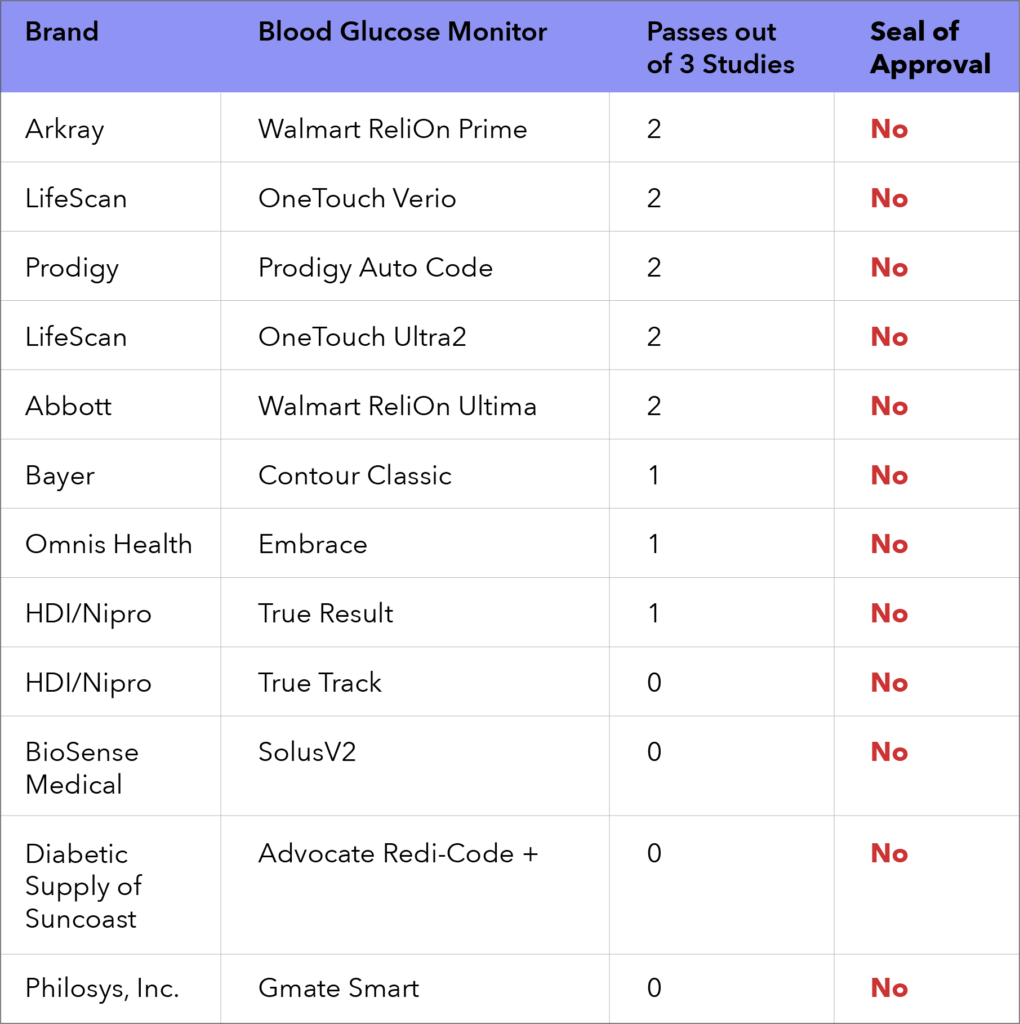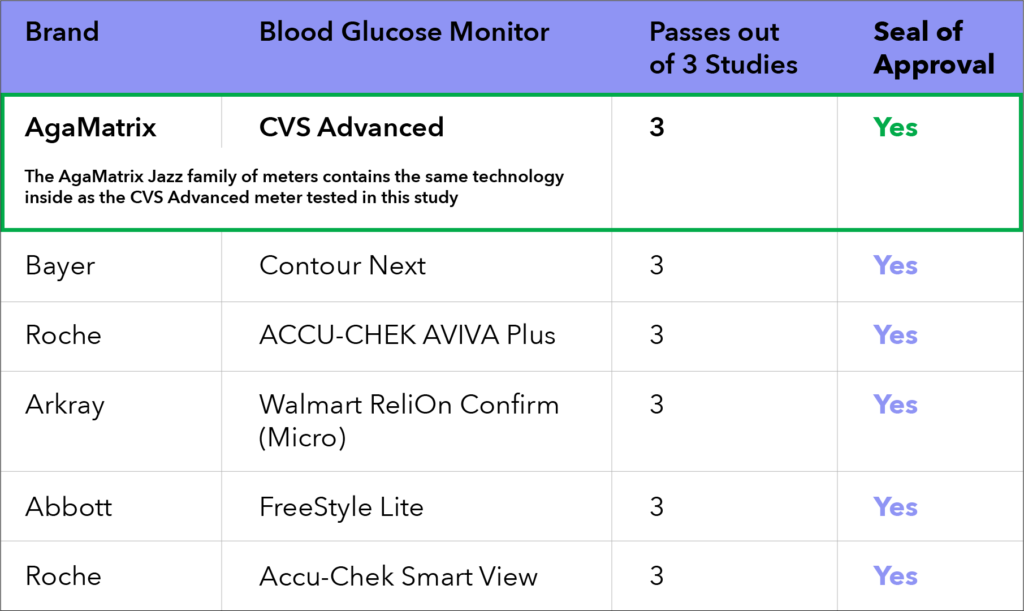What Is Good Glucose Reading Using a Metering Device
Since your readings make up one's mind your insulin doses, diet choices, and other health factors, having an accurate blood glucose meter is crucial for managing your diabetes.
Read on to dive into:
- How Blood Glucose Accuracy is Determined
- 8 Factors That Affect Meter Accuracy
- How to Choose an Authentic Meter
- How to Examination Your Meter
How Blood Glucose Accuracy is Determined
Blood glucose is measured primarily in two ways:
- Laboratory tests performed by professional person healthcare providers
- Personal blood glucose meters
How are these tests unlike?
Personal meters mensurate your blood glucose using a sample from your fingertip (or alternate site), and then analyze the whole blood, including cherry blood cells and all.
In a lab test performed by clinical staff, the sample is typically drawn from a vein in your arm and processed to remove red blood cells, so only the plasma is tested.
Virtually all home glucose meters factor in the difference of using a whole blood sample while providing a examination result that is considered plasma equivalent.
Which is more accurate?
Lab tests by and large demonstrate a college level of accurateness than personal blood glucose meters, but even these machines can have a slight margin of error. Blood glucose meter examination results are not exact measures, only they're designed to requite you accurate readings for daily handling decisions when y'all're not at a doctor's office.
Without going into detail on how your circulatory system works, there are other factors that may crusade the two readings to vary slightly, but typically a issue from a meter that'due south within 15-20% of your lab reading is considered accurate. And then, if your lab result says that your claret glucose is 100 mg/dL, your meter might study your results equally 85 mg/dL or 115 mg/dL and withal be considered accurate.
Who determines accuracy?
ISO, as well known as the International Arrangement for Standardization, is responsible for developing and publishing specifications for products and services. The standards set by the organization are intended to ensure quality, safety, and efficiency, and then that you tin be confident in your purchases.
Blood glucose meters are one of the many products with ISO standards. For a system to meet the latest ISO 15197:2013 accuracy standard, 95% of claret glucose results must be within 15% (for values equal to or greater than 100 mg/dL) and 15 mg/dL (for values beneath 100 mg/dL). It also requires 99% of results to autumn within zones A or B of the Consensus Mistake Grid.
The FDA, which oversees products cleared in the U.S., has its own system accurateness recommendations. Their most recent draft guidance represents their current thinking on accuracy and relies heavily on the ISO guidelines.
8 Factors That Can Affect Glucose Meter Accuracy
Test Strips
When you lot utilize a examination strip, the glucose in your blood interacts with enzymes on the strip. This releases electrons, creating an electrical current. The meter and then converts that into a concentration of glucose to give yous a reading.
Because this procedure is so complicated, your test strips can be very sensitive to variables. Inaccurate results can come from test strips that:
- Are damaged or expired
- Are afflicted by oestrus or wet
- Exercise not have enough claret applied
- Are non designed for your meter
- Accept contaminants (oil, lotion, food) on the sample area
Accuracy Tip: You should always keep your test strips in their container, stored at the temperature specified by the manufacturer. Test strip designs may vary, then it's important to understand where the claret sample should be practical to avoid testing errors or inaccurate results. Also make sure that you're using tests strips that accept not expired and are made specifically for your meter model.
Environmental Weather
The chemistry of your exam strips, as well as your own blood flow and composition, tin can be affected by the atmospheric condition of your surround.
An active component in the exam strip chemical science, called an enzyme, can be sensitive to temperature and humidity conditions. Temperature and humidity extremes can crusade the enzyme activity to decrease and impact the accuracy of results.
Your body likewise reacts differently at different temperatures. High temperatures can make it easier for you to become dehydrated and concentrate (elevate) glucose levels, while low temperatures may impact circulation and lower blood flow to testing sites.
Some studies have shown devices to over or under gauge glucose when testing at high altitudes. If this is of concern, confirm the distance rating for your device.
Accuracy Tip: Go on examination strips at room temperature and keep the container closed so your strips are protected from the elements. This means taking them with y'all wherever you go to avoid leaving them in a hot or cold car. If yous take been exposed to colder temperatures and your easily do not feel warm, wash and concur them under warm water earlier taking a examination to improve blood flow and reduce meter errors.
Substances on Your Pare
Anything you bear on or put on your pare tin can end up in your claret sample and and so on your exam strip. Since many current meters utilize a micro-sized blood sample, just touching something that contains carbohydrate and non washing your hands tin can affect your readings. If you recently washed your hands but didn't dry them completely, the water left on your fingers tin have a diluting effect on the sample, as well.
Accuracy Tip: Ever wash and thoroughly dry your hands before every test.
Corporeality of Blood in Your Test Strip
It'south possible to have too much or not enough blood in the test strip sample area, which can lead to inaccurate results or an error reading.
Accuracy Tip: Your meter should state the required blood sample size, like 0.v microliters, then yous take an understanding of how much claret is needed for testing. Avoid squeezing directly effectually the lanced surface area when forming a blood drop. You tin too experiment with different size lancets to discover one that produces the amount y'all demand.
Testing Site Location
Considering of the physiological differences in the circulation of certain areas of your torso, examination results from alternating sites (like your forearms, calf, or thigh) are often less accurate than testing with your fingertip. This is due to the frequency with which fresh blood is circulated to each part of the body. If you have recently eaten, exercised, or taken medication that could lower your glucose, these changes may not exist detected as rapidly in alternating sites every bit in the fingertip.
Accurateness Tip: Check the instructions for your meter to understand how alternating site testing may affect your results.
Hematocrit Variations
Variations in your hematocrit — the proportion of red blood cells in your claret — tin affect the accuracy of your blood glucose meter. These variances in the amount of reddish blood cells can interfere with the adding of glucose.
The ISO 15197:2013 standard requires functioning criteria that limits the effect of varying hematocrit levels on a blood glucose meter. If the meter you're using does not run into this criteria, y'all may receive inaccurate results.
Accuracy Tip: Many meters with the latest technology tin detect and correct for hematocrit variations. Check the guide that came with your meter or contact the manufacturer for more than details.
Meter Variances
The calibration process, enzymes, and reckoner programs (algorithms) in every meter on the market are dissimilar. Each brand'due south manufacturing, chemical science, and scale process can differ, fifty-fifty across production lines from the same company. If you're using i meter brand/model in the morning and another at night, your readings tin can have significant variations.
Accuracy Tip: Stick with one meter to go far easier to interpret your glucose levels and the outcome of handling decisions.
Wrong Coding
A meter that requires coding means you'll need to input a code printed on each exam strip vial in order to calibrate it before use. If the code doesn't match correctly, it could atomic number 82 to inaccurate readings.
Accuracy Tip: Many "No Code" meters are available now, which lets you avert this pace. Simply if you lot have a meter that still requires coding, make sure yous input the lawmaking correctly to avoid inaccuracies.
How to Cull an Accurate Meter
Independent testing, like the study done by the Diabetes Technology Society, is helpful to compare the performance of height commercially bachelor glucose meters. This study tested meters and exam strips which were independently purchased from stores across the land, and representative of what a consumer would buy.
Later testing the products over 300 times at iii different clinical sites, the results showed that over 66% of the acme meters on the market today didn't pass the rigorous study.
A surprising number of name brand meters did not pass all studies. Bank check the listing beneath to see the 12 meters that failed one or more study.

The post-obit devices passed the examination and received the Diabetes Engineering Society's Seal of Approval:

AgaMatrix & Meter Accuracy
In the above-mentioned study, you lot tin see that AgaMatrix performed every bit good or better than many of the leading brands. The results showed that 97% of our readings were within ±fifteen% or ±15 mg/dl of the lab test results.
All AgaMatrix products, including claret glucose meters and exam strips, are backed by earth-class manufacturing techniques in our ISO 13485:2016-certified and FDA-registered facility. We live by the principles of efficiency and precision by continuously reviewing our design, assembly, and automation practices and then that people living with diabetes tin can accept access to affordable, authentic technology that helps them better manage their health.
To detect an AgaMatrix meter that suits your lifestyle, you tin can shop here or contact u.s. for help!
Source: https://agamatrix.com/blog/blood-glucose-meter-accuracy/
0 Response to "What Is Good Glucose Reading Using a Metering Device"
Enregistrer un commentaire